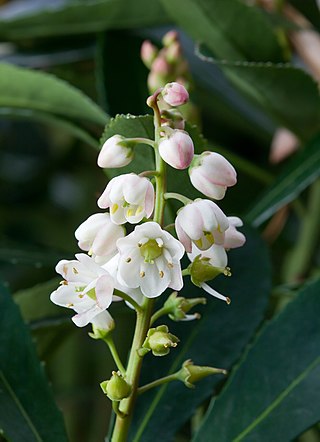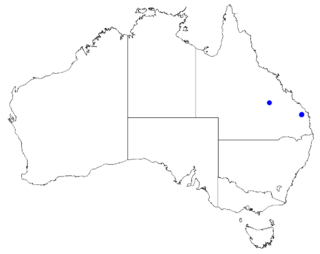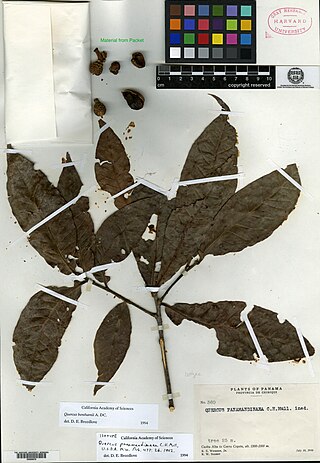
Pouteria lucuma is a species of tree in the family Sapotaceae, cultivated for its fruit, the lúcuma. It is native to the Andean valleys of Bolivia, Ecuador, and Peru.
Youngia nilgiriensis is an endangered perennial herb. It is endemic to the Sispara area of the Kundah range of the Nilgiri Hills, Tamil Nadu, South India characterised by vast stretches of grasslands interrupted by numerous sholas at an altitude of around 2,060 metres (6,760 ft). It is listed as an endangered species in the Red Data Book on Indian Plants.
Alfaroa manningii, or gavilán colorado, is a valued lumber tree of the Walnut family endemic to the premontane Costa Rican rain forest. The specific epithet honors the American botanist Wayne Eyer Manning (1899–2004).

Anopterus glandulosus, commonly known as native laurel or Tasmanian laurel, is a species of shrub or small tree in the family Escalloniaceae. Endemic to south and southwestern Tasmania, A. glandulosus is widespread in the moist understoreys of Tasmanian temperate rainforests and wet sclerophyll forests from sea level to mountainous regions below 1,200 metres (3,937 ft) above sea level.

Monanthes anagensis is the largest species in the genus Monanthes, forming little bushes about 15 centimetres (5.9 in) high. Leaves are laxly spaced, linear-elliptic, quite smooth, and 1.5–2 centimetres (0.6–0.8 in) long. When stunted it somewhat resembles Monanthes laxiflora but differs from any form of that variable species in its distinctly shrubby habit, alternate longer and narrower leaves which are green, red, or purplish, never grey, and ovoid buds, the buds of M. laxiflora being broader than long.

Costus curvibracteatus is a tropical rhizomatous perennial native to Costa Rica and Panama. A member of the spiral ginger family of plants, its common name is orange tulip ginger. It is also sometimes referred to as spiral ginger; however, this common name is better associated with Costus barbatus, a more widely cultivated and very similar species. Despite the name and its relation to the ginger family (Zingiberaceae), the rhizomes of the orange tulip ginger are not edible.
Zieria exsul is a plant in the citrus family Rutaceae and is endemic to a small area of southeast Queensland. It is an open, straggly shrub with hairy branches, three-part leaves and white flowers in groups of up to twelve, the groups longer than the leaves and each flower with four petals and four stamens.
Uvariopsis korupensis is a species of flowering plant in the family Annonaceae endemic to Cameroon.

Cyanothamnus nanus, commonly known as the dwarf boronia or small boronia is a plant in the citrus family Rutaceae and is endemic to eastern Australia. It is a prostrate or low spreading shrub with simple or three-part leaves and white or pale pink four-petalled flowers.

Cyanothamnus defoliatus is a plant in the citrus family, Rutaceae and is endemic to the south-west of Western Australia. It is a straggly shrub with simple, thread-like leaves and white to pink, four-petalled flowers that are pale blue on the back.

Boronia foetida is a plant in the citrus family Rutaceae and is endemic to a small area in Queensland. It is an erect shrub with hairy branches, simple leaves and pink to white, four-petalled flowers usually arranged singly in leaf axils. The leaves have an unpleasant smell when crushed.
Cyanothamnus montimulliganensis is a plant in the citrus family Rutaceae and is endemic to a single mountain in Queensland. It is an erect, woody shrub with pinnate or bipinnate leaves and white, four-petalled flowers usually arranged singly in leaf axils.

Cyanothamnus polygalifolius, commonly known as dwarf boronia, milkwort-leaved boronia or milkwort boronia, is a plant in the citrus family Rutaceae and is endemic to eastern Australia. It is a low-lying shrub with simple leaves and white or pink flowers arranged singly or in groups of up to three in leaf axils.
Rubia agostinhoi is a climbing plant species of the Rubiaceae family endemic to the Azores It was defined by ecologist Pierre Dansereau and Pinto da Silva in 1977.
Zanthoxylum austrosinense, or South Chinese Sichuan pepper, is a woody plant in the family Rutaceae and is native to southern China.

Symphyotrichum kentuckiense is a rare species of flowering plant in the Asteraceae family and is commonly known as Kentucky aster, Price's aster, Miss Price's aster, Sadie's aster, or lavender oldfield aster. It is a perennial, herbaceous plant that is endemic to broken limestone cedar glades and roadsides in Alabama, Georgia, Kentucky, and Tennessee. It blooms from August through October, reaches heights between 30 centimeters and 100 cm (3.3 ft), and has green to reddish-brown stems. It is a nearly hairless plant with blue to blue-violet ray florets.
Pentagonia gomez-loritoi is a "palmoid" or "Corner Model Tree" of the Costa Rican and Panamanian rainforest belonging to the family Rubiaceae. It is usually single-trunked up to 19.5 feet in height. It is most noteworthy for its pairs of huge, entire margined, shiny oblanceolate leaves; each leaf up to 4 ft.7in. in length by up to 22 inches in width. petiole very short or none. The pairs of leaves are spaced several inches apart along the stem. This species was totally unknown prior to 2014.

Micromeria glomerata, known locally as cliffthyme or thyme of Taganana, is a species of plant with woody chameleophyte flowers, belonging to the Lamiaceae family. It is a species endemic to the northeast of the Canary Island of Tenerife, whose description was first made in 1974, thanks to botanist Pedro Luis Pérez de Paz. It is a medicinal and aromatic plant with pink-purple flowers that grows at low altitude in the crevices of the slopes of the protected area of the Anaga Rural Park, located in the massif of the same name. The flexible, puberulose stem and with internodes can reach 10 to 40 centimeters in height. On the other hand, the leaves are small and flat, 8 mm long by 6 mm wide.11

Quercus panamandinaea is a species of oak tree native to Costa Rica and Panama. It belongs to Quercus sect. Lobatae within Quercus subg. Quercus and is named after its distribution in Panama and the Andean region. It prefers a wet, tropical biome.
Monstera alfaroi is a flowering plant in the arum family. It is endemic to mid-altitude premontane rainforests of Costa Rica at altitudes of 1,100 to 1,250 metres. M. alfaroi features light brown petioles with black or white warts. It is closely related to Monstera buseyi, but M. alfaroi can be distinguished by its larger inflorescence. M. alfaroi is also easily confused with M. costaricensis, which can be distinguished from M. alfaroi by its petioles with white pustules, more conical inflorescence, and location; M. costaricensis only occurs in lowland areas of Costa Rica below 600 metres (2,000 ft). Mature plants have ovate leaf blades as long as 90 centimetres (35 in) and 45 centimetres (18 in) wide, with few circular fenestrations near the midrib. From petiole to blade tip, M. alfaroi leaves can be up to 160 centimetres (63 in) long. It has a white spadix and an externally light green spathe. Flowering has been recorded in November, and fruiting in January.










